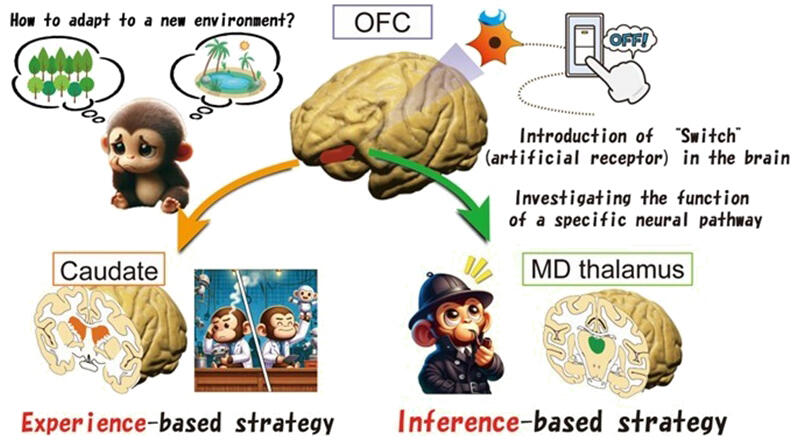To flexibly adapt to environmental changes, primates use different brain circuits for the experience-based approach, in which they repeat trial and error, and the inference-based approach, in which they apply prior knowledge and theory to efficiently select the most appropriate behavior. Deputy Manager Takafumi Minamimoto and Senior Researcher Kei Oyama of the Advanced Neuroimaging Center at the National Institutes for Quantum Science and Technology (QST), in collaboration with Professor Masahiko Takada of the Center for the Evolutionary Origins of Human Behavior at Kyoto University, discovered two different thinking circuits: experience-based and inference-based. Minamimoto said, "In this study, we could identify these brain circuits in the same macaque monkey by combining chemogenetics and imaging. Since the same results were obtained from the two animals, we can demonstrate that the differences were not due to the distinct characteristics of the monkeys. We hope to apply our method to research on other thinking circuits." The results were published in Nature Communications.

Provided by QST
Previous studies have shown that the orbitofrontal cortex, located in the lower part of the prefrontal cortex of the brain, is important for experience-based and inference-based thinking. However, it was unclear which neural pathways mediate the transmission of these commands from the orbitofrontal cortex to other brain regions.
The research group first developed behavioral tasks to examine what thinking approaches the monkeys use during changes in situations in which they have and do not have experience. A touch panel placed in front of the monkeys displayed two out of a set of five images. When the monkeys touched either of the images, they were rewarded with a defined amount of juice based on which image they touched. There were two tasks: a novel image task in which a new set of images were used and a familiar image task. In both tasks, the association between the images and the amounts of juice was reversed within a session to change the situation.
The monkeys completed 300 trials of the novel image task per day, with the image-reward association being reversed only once after 90 trials. The familiar image task was repeated 300−400 times/day, with the reversal occurring many times during the session. The data and models confirmed that the monkeys solved novel and familiar image tasks based on experience- and inference-based thinking, respectively.
An artificial receptor was introduced to neurons in the orbitofrontal cortex of these monkeys. After confirming the expression of the artificial receptor by PET, the artificial drug DCZ, which can stop cellular activity, was administered to silence the orbitofrontal cortex. The DCZ treatment slowed relearning after reversal in both the behavioral tasks. This result indicates that the orbitofrontal cortex is deeply involved in both experience- and inference-based thinking processes to appropriately adapt to changes in situations.
Next, they used PET to identify the brain region where the neural information related to experience- and inference-based ways of thinking was sent from the orbitofrontal cortex before the realization of thinking. They successfully mapped neural pathways from the orbitofrontal cortex to the rostromedial caudate and thalamic mediodorsal nucleus. DCZ treatment of the artificial receptor expressed at the terminals of these neural pathways to stop information transmission resulted in slowed relearning after the reversal only for the novel image task and impaired experience-based thinking when information transmission via the pathway from the orbitofrontal cortex to the caudate nucleus was stopped. Conversely, when the information transmitted via the pathway from the orbitofrontal cortex to the thalamus was stopped, the relearning of familiar images was delayed, and the inference-based thinking was impaired. Based on these results, they found two thinking circuits that adapt to changing situations: a circuit from the orbitofrontal cortex to the caudate nucleus, which is important for experience-based thinking, and a circuit from the orbitofrontal cortex to the thalamus, which is important for inference-based thinking.
Oyama said, "Disturbed information flow from the orbitofrontal cortex is thought to underlie the obsessive-compulsive symptoms and impulsiveness seen in obsessive-compulsive disorder. The findings may also contribute to clinical studies toward the establishment of diagnostic and therapeutic methods, including the creation of a monkey model temporarily reproducing these symptoms for testing pathophysiological hypotheses of the disorder and exploration for therapeutic agents to improve the pathophysiology of the disorder."
Journal Information
Publication: Nature communications
Title: Distinct roles of monkey OFC-subcortical pathways in adaptive behavior
DOI: 10.1038/s41467-024-50505-8
This article has been translated by JST with permission from The Science News Ltd. (https://sci-news.co.jp/). Unauthorized reproduction of the article and photographs is prohibited.




